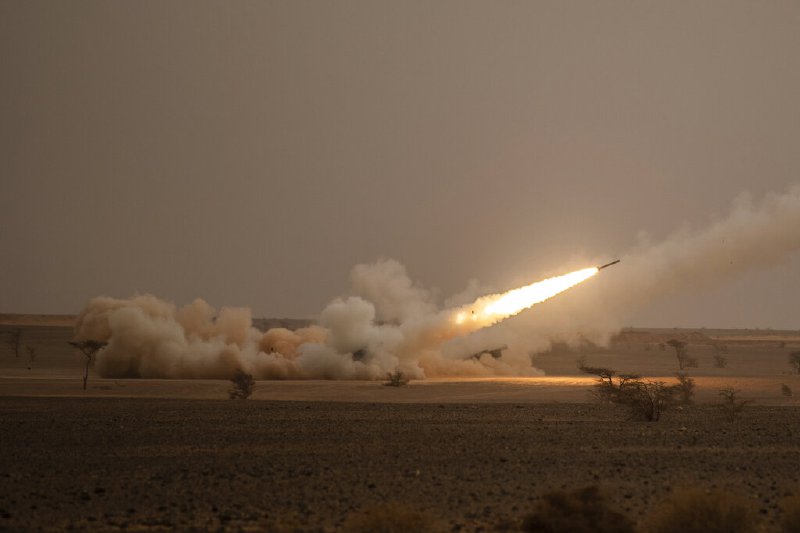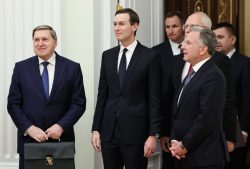
FILE – A launch truck fires the High Mobility Artillery Rocket System (HIMARS) at its intended target during the African Lion military exercise in Grier Labouihi complex, southern Morocco, on June 9, 2021.
14:31 JST, September 13, 2022
WASHINGTON (AP) — U.S. leaders from President Joe Biden on down are being careful not to declare a premature victory after a Ukrainian offensive forced Russian troops into a messy retreat in the north. Instead, military officials are looking toward the fights yet to come and laying out plans to provide Ukraine more weapons and expand training, while warily awaiting Russia’s response to the sudden, stunning battlefield losses.
Although there was widespread celebration of Ukraine’s gains over the weekend, U.S. officials know Russian President Vladimir Putin still has troops and resources to tap, and his forces still control large swaths of the east and south.
“I agree there should be no spiking of the ball because Russia still has cards it can play,” said Philip Breedlove, a retired U.S. Air Force general who was NATO’s top commander from 2013 to 2016. “Ukraine is now clearly making durable changes in its east and north and I believe that if the West properly equips Ukraine, they’ll be able to hold on to their gains.”
Lawmakers particularly pointed to the precision weapons and rocket systems that the U.S. and Western nations have provided to Ukraine as key to the dramatic shift in momentum, including the precision-guided High-Mobility Artillery Rocket System, or HIMARS, and the High-speed Anti-Radiation Missile, or HARM, which is designed to target and destroy radar-equipped air defense systems.
“They’re there, they’re in theater, and they’re making the difference,” Sen. Chris Coons, a Delaware Democrat and member of the Senate Foreign Relations Committee. In the hands of highly motivated Ukrainian fighters who are making the most of weapons ranging from off-the-shelf drones and abandoned Russian arms to advanced weapons from the West, the HIMARS are enabling Ukrainians “to turn the tide, dramatically,” Coons said.
Meanwhile, a senior defense official said the U.S. is looking at future needs, including discussions about providing more intensive combat training for larger Ukraine units, a change from current training focused on smaller teams learning to handle specific weapons. It is also considering sending additional air defense systems, as well as lethal strike drones and more surveillance drones. The official was one of two who briefed reporters Monday on condition of anonymity to discuss planning details.
Ukraine’s launch in recent days of a much-anticipated counteroffensive — in a different part of the country from where Russian troops occupying Ukraine had massed strength to meet it — has brought on the biggest territorial changes in months in the 200-day war, launched when Putin rolled Russian forces into the neighboring country, targeting its Western-oriented government.
The U.S. officials acknowledged that the U.S. provided information to help the Ukrainian counteroffensive, but declined to say how much or if Western officials helped strategize the idea to throw Russian forces off guard by calling attention to attack plans in the south, while actually plotting a more formidable campaign in the east.
The U.S provided information “on conditions” in the country, said one of the officials, but “in the end, this was the Ukrainian choice. The Ukrainian military and the Ukrainian political leadership made the decisions on how to conduct this counteroffensive.”
Ukrainian forces claimed Monday to have retaken a wide band of territory and more than 20 Ukrainian settlements from Russia, pushing all the way back to the two countries’ northeastern border. Russian soldiers were surrendering in such numbers that Ukraine was having difficulty making room for them, Ukrainian military officials said.
Ukrainians have pounded 400 targets in all with the HIMARS since the U.S. began supplying them, using them “with devastating effect,” Army Gen. Mark Milley, chairman of the Joint Chiefs of Staff, told reporters late last week as Ukraine’s counteroffensive was getting underway.
The truck-mounted, GPS-guided systems fire faster, farther and more precisely than the Soviet-designed rocket launchers otherwise used by both Russia and Ukraine. They can hit targets up to 80 kilometers (50 miles) away. Ukrainian forces have used the 16 HIMARS and several similar systems to strike supply lines, ammunition depots and other key Russian targets.
The Ukrainians “believe that this has happened because of the new technology equipment and weapons that we’ve sent them. They … said well, if you would have sent them six months ago,” said Sen. Dick Durbin, an Illinois Democrat. “We didn’t have them six months ago, but you know, we had to build the weaponry, and train their people on it, takes time.”
Still, Ukrainian leaders are still pressing for more — including fighter jets and the longer-range Army Tactical Missile System, or ATACMS, a surface-to-surface missile that the U.S. has so far declined to send.
A key question going forward will be how much more Congress and the American public are willing to spend on the war in Ukraine, which the U.S. and the West say also represents a significant threat to Europe.
It’s unclear if, or how, Ukraine fighters’ successes in recent day will affect the ongoing debate. The White House has asked Congress to greenlight an additional $11.7 billion in aid as part of an overall government funding measure that lawmakers must approve before the end of the month.
“I haven’t seen any lack of appetite so far” for continuing funding for Ukraine, said Sen. Roy Blunt, R-Mo. “I think to see the ability to take the help that they’ve been given and then be clearly successful in some of their efforts is an encouragement to want to do more of that.”
The U.S. — the lead contributor to Ukraine’s war effort among NATO members — has poured more than $15 billion in weapons and other military support into Ukraine since January.
Biden acknowledged the battlefield gains for Ukraine over the weekend but refused to say more. “I’m not going to speak to that now because things are in process,” he told reporters.
Breedlove noted that despite the recent battle losses, Putin still has “a lot of tanks and a lot of trucks and a lot of people that he can still throw at this problem. They’re just not his best tanks, his best trucks or his best people.”
But he warned that winter may bring the most daunting challenge. Putin’s moves to shut down fuel supplies to Europe, which is expected to increase prices, are likely aimed at turning public opinion across the region.
“Even though Mr. Putin’s military has taken a beating on the military front, his big card, yet probably to play is how well does Europe hold together through a winter that Mr. Putin is going to make completely miserable for the European people,” Breedlove said. “I think Mr. Putin is desperately trying to hang on to winter because his big hope now is to separate the European people from their European political leadership.”
"News Services" POPULAR ARTICLE
-

American Playwright Jeremy O. Harris Arrested in Japan on Alleged Drug Smuggling
-

Japan’s Nikkei Stock Average as JGB Yields, Yen Rise on Rate-Hike Bets
-

Japan’s Nikkei Stock Average Licks Wounds after Selloff Sparked by BOJ Hike Bets (UPDATE 1)
-

Japan’s Nikkei Stock Average Buoyed by Stable Yen; SoftBank’s Slide Caps Gains (UPDATE 1)
-

Japanese Bond Yields Zoom, Stocks Slide as Rate Hike Looms
JN ACCESS RANKING
-

Keidanren Chairman Yoshinobu Tsutsui Visits Kashiwazaki-Kariwa Nuclear Power Plant; Inspects New Emergency Safety System
-

Imports of Rare Earths from China Facing Delays, May Be Caused by Deterioration of Japan-China Relations
-

University of Tokyo Professor Discusses Japanese Economic Security in Interview Ahead of Forum
-

Tokyo Economic Security Forum to Hold Inaugural Meeting Amid Tense Global Environment
-

Japan Pulls out of Vietnam Nuclear Project, Complicating Hanoi’s Power Plans
























